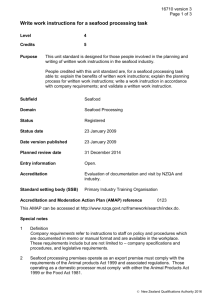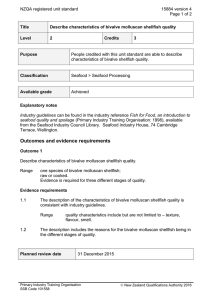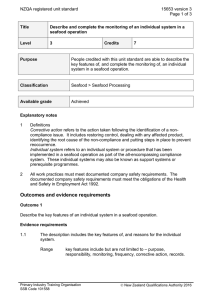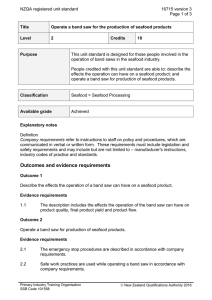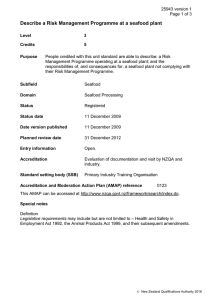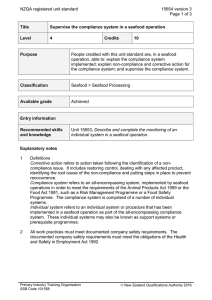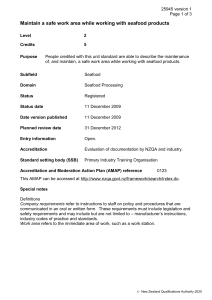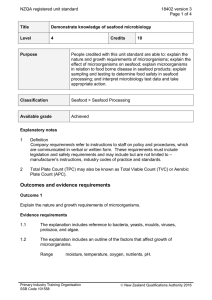NZQA registered unit standard 16714 version 4 Page 1 of 3
advertisement
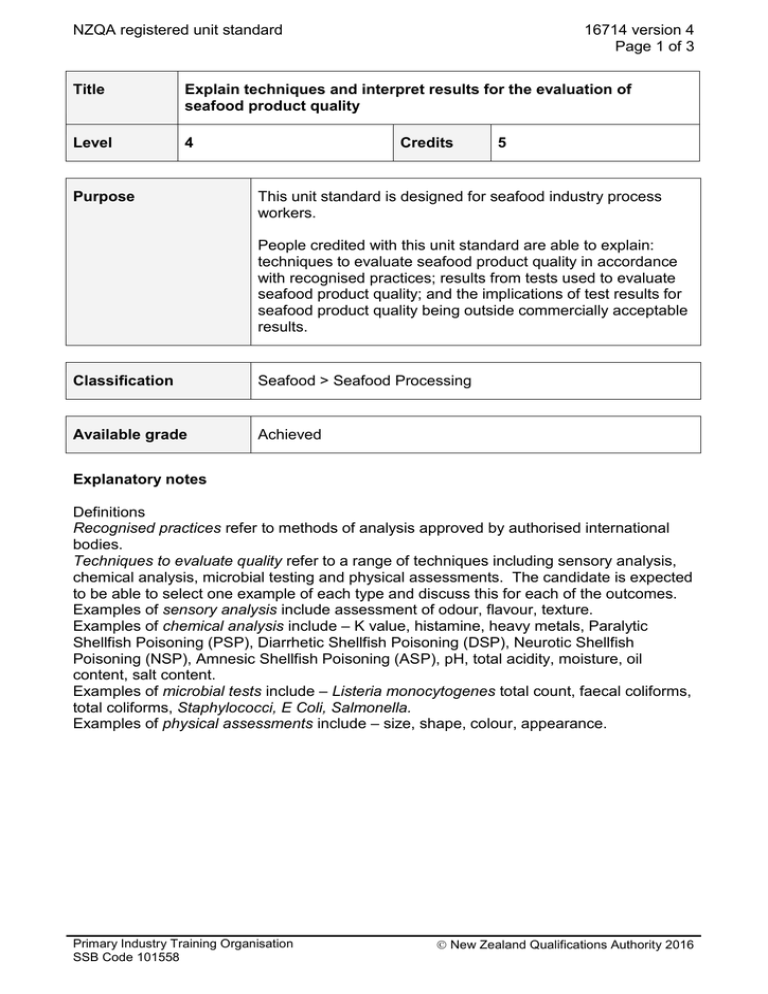
NZQA registered unit standard 16714 version 4 Page 1 of 3 Title Explain techniques and interpret results for the evaluation of seafood product quality Level 4 Purpose Credits 5 This unit standard is designed for seafood industry process workers. People credited with this unit standard are able to explain: techniques to evaluate seafood product quality in accordance with recognised practices; results from tests used to evaluate seafood product quality; and the implications of test results for seafood product quality being outside commercially acceptable results. Classification Seafood > Seafood Processing Available grade Achieved Explanatory notes Definitions Recognised practices refer to methods of analysis approved by authorised international bodies. Techniques to evaluate quality refer to a range of techniques including sensory analysis, chemical analysis, microbial testing and physical assessments. The candidate is expected to be able to select one example of each type and discuss this for each of the outcomes. Examples of sensory analysis include assessment of odour, flavour, texture. Examples of chemical analysis include – K value, histamine, heavy metals, Paralytic Shellfish Poisoning (PSP), Diarrhetic Shellfish Poisoning (DSP), Neurotic Shellfish Poisoning (NSP), Amnesic Shellfish Poisoning (ASP), pH, total acidity, moisture, oil content, salt content. Examples of microbial tests include – Listeria monocytogenes total count, faecal coliforms, total coliforms, Staphylococci, E Coli, Salmonella. Examples of physical assessments include – size, shape, colour, appearance. Primary Industry Training Organisation SSB Code 101558 New Zealand Qualifications Authority 2016 NZQA registered unit standard 16714 version 4 Page 2 of 3 Outcomes and evidence requirements Outcome 1 Explain techniques to evaluate seafood product quality in accordance with recognised practices. Range one for each of – sensory, chemical, microbial, physical. Evidence requirements 1.1 The explanation outlines how the technique is carried out. 1.2 The explanation outlines the circumstances under which the technique would be used. Outcome 2 Explain results from tests used to evaluate seafood product quality. Range one of each of – sensory, chemical, microbial, physical. Evidence requirements 2.1 The explanation outlines the acceptable limits for each test result in accordance with company requirements. Outcome 3 Explain the implications of test results for seafood product quality being outside commercially acceptable results. Range one of each of – sensory, chemical, microbial, physical. Evidence requirements 3.1 The explanation includes two options for end use of product, and other possible risk management issues associated with the product are explained, in accordance with company requirements. 3.2 Test results that are outside company limits are explained in terms of two possible causes of unacceptable test results. 3.3 The explanation outlines two factors that need to be focussed on to prevent reoccurrence of unacceptable test results. Planned review date Primary Industry Training Organisation SSB Code 101558 31 December 2015 New Zealand Qualifications Authority 2016 NZQA registered unit standard 16714 version 4 Page 3 of 3 Status information and last date for assessment for superseded versions Process Version Date Last Date for Assessment Registration 1 30 July 1999 31 December 2012 Revision 2 12 June 2001 31 December 2012 Review 3 23 January 2009 31 December 2012 Review 4 18 February 2011 N/A Accreditation and Moderation Action Plan (AMAP) reference 0123 This AMAP can be accessed at http://www.nzqa.govt.nz/framework/search/index.do. Please note Providers must be granted consent to assess against standards (accredited) by NZQA, or an inter-institutional body with delegated authority for quality assurance, before they can report credits from assessment against unit standards or deliver courses of study leading to that assessment. Industry Training Organisations must be granted consent to assess against standards by NZQA before they can register credits from assessment against unit standards. Providers and Industry Training Organisations, which have been granted consent and which are assessing against unit standards must engage with the moderation system that applies to those standards. Consent requirements and an outline of the moderation system that applies to this standard are outlined in the Accreditation and Moderation Action Plan (AMAP). The AMAP also includes useful information about special requirements for organisations wishing to develop education and training programmes, such as minimum qualifications for tutors and assessors, and special resource requirements. Comments on this unit standard Please contact the Primary Industry Training Organisation standards@primaryito.ac.nz if you wish to suggest changes to the content of this unit standard. Primary Industry Training Organisation SSB Code 101558 New Zealand Qualifications Authority 2016

